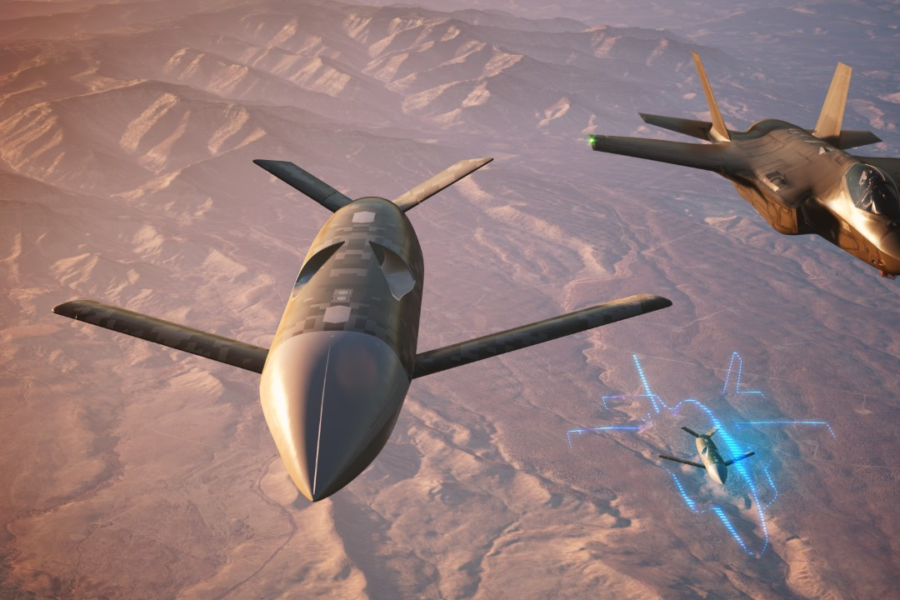The Air Force is looking for a single airframe on which to build its Collaborative Combat Aircraft concept, with interchangeable, modular elements, service Secretary Frank Kendall said March 15. And while he has set 1,000 as the “planning number” for the new class of combat aircraft, the true requirement could be twice that, he said.
The CCA the Air Force has in mind would have “a common chassis, a common airframe” with modular mission equipment “optimized against the threat that you expect to face,” Kendall told reporters after his March 15 speech at the annual McAleese defense conference.
“A reasonable way to think about it is an airframe with different payloads that can be swapped out, depending on the mission,” he explained.
It has not previously been clear whether the Air Force envisioned CCAs to be a range of dedicated aircraft in different classes or a single type with many variants to perform a variety of missions.
In his speech, Kendall said that he gave USAF planners a figure of 1,000 CCAs as a notional target.
The figure will allow planners to ‘start thinking about organizational structures: whether they’re hybrid structures, with crewed and uncrewed aircraft in the same wing, or separate structures … that would work together,” Kendall explained.
In addition to force structure and organizational considerations, planners will also be mapping out what CCAs will require with regard to training, maintenance, range space and sustainment, he noted.
Kendall said he used the figure of 1,000 to convey to industry and Capitol Hill that CCAs are a major new initiative, that the Air Force is sincere about it, and that it needs to get underway as quickly as possible.
“What I wanted to do is give people a … sense of the kinds of numbers we’re talking about. We’re not talking about 10 or 100 or 200; we’re talking a serious number of aircraft here,” Kendall said in a Q&A after his presentation.
That serious number could wind up far exceeding the notional 1,000, he hinted.
“I think, at the end of the day, we’ll end up with more than that. … It could be twice that number or more. I don’t know yet,” said Kendall.
Air Force officials have said the planning figure was meant to send an unambiguous signal to industry that the Air Force intends to go ahead with CCAs and that their investment in technologies and concepts underwriting the concept will be worthwhile.
Kendall said in a briefing ahead of the budget release that the plan will be to carry two CCA airframe concepts through initial development, but he couldn’t say on what timeline the Air Force will select one type for production. However, whichever contractor is chosen to build the basic airframe, the Air Force’s intent is to compete the modular payloads thereafter, thus avoiding one companying having “vendor lock” on the CCA fleet.
He emphasized that developing and fielding CCAs will not come at the expense of manned aircraft, but as an enabling adjunct to them. He again made the analogy that CCAs can be thought of as independent platforms to carry the weapons, sensors, and other payloads that today’s crewed fighters carry, thus expanding the amount of sensors and weapons USAF can bring to the battle.
Kendall also joked that the CCA might join the Air Force’s “4+1” fighter plan as the “+1,” replacing the retiring A-10.
Last week, Kendall said he expected these aircraft to achieve initial operational capability “by the end of the decade,” and in parallel with the Next Generation Air Dominance (NGAD) family of systems, which will succeed the F-22 in about the same timeframe.
Besides the NGAD and F-35, Kendall said the F-15EX could also conceivably be a “controlling aircraft” for CCAs.
It’s premature to think about where CCAs might be based, Kendall said, calling the politically charged process of assigning aircraft to congressional districts “the bane of my existence.” However, service officials said the advent of such a large new addition to the force should make it more palatable to members of Congress to allow divestiture of legacy platforms in their districts, knowing that new systems are coming in that will likely re-use existing facilities.
The Air Force will work to hold the cost of CCAs to “a fraction” of the cost of an F-35, Kendall said, but he said it’s premature to estimate what that will be. He has previously said a CCA might come in at half the cost of an F-35, which in the last contract cost the Air Force about $80 million per copy.
“We’ve got a lot of work to do” on the CCA program and “we have to work on cost effectiveness,” Kendall said. “Where we’re going to end up” with regard to inventory, cost or exact mission “we’re not sure, yet.” But he also emphasized that “these are not zero-cost” systems.
“They’re not munitions … and they’re not attritable [but] I’m pretty comfortable we’re on the right path,” Kendall said.

